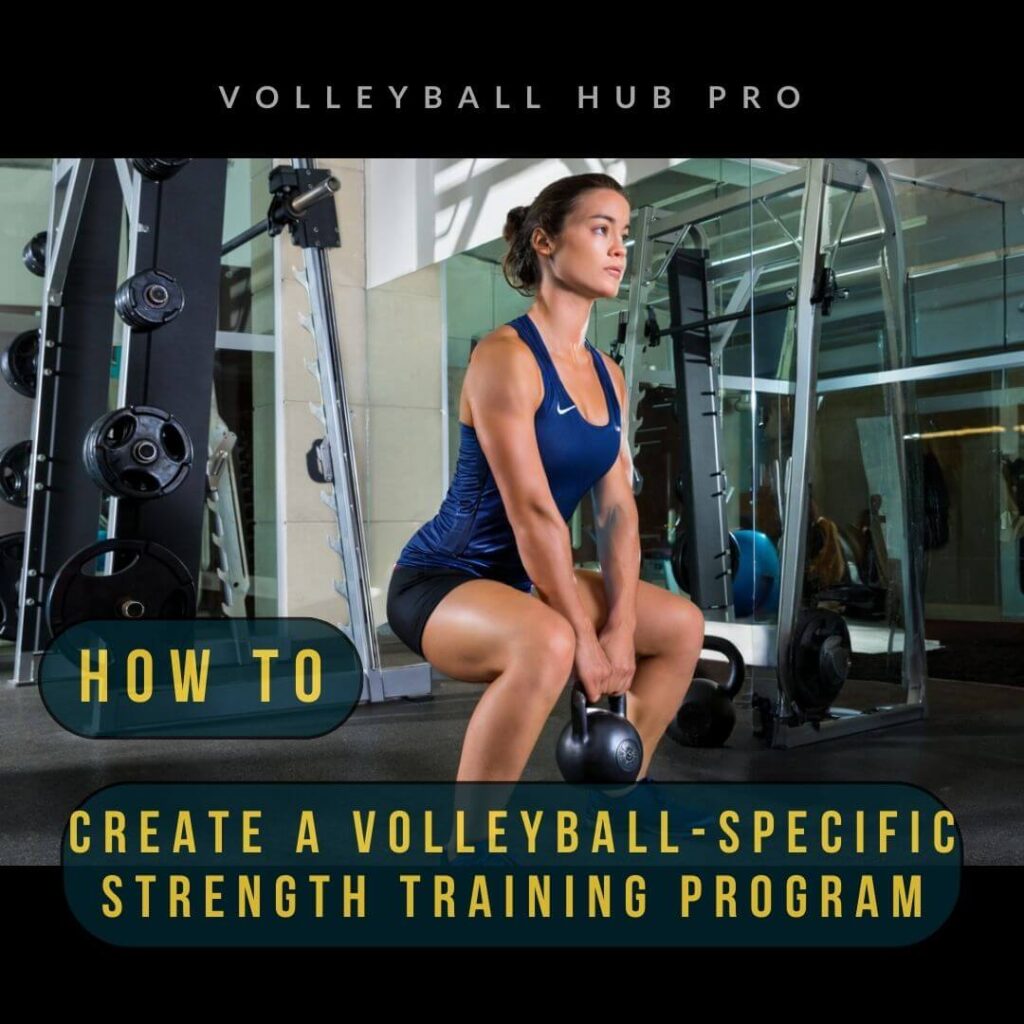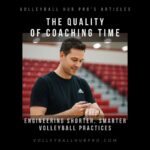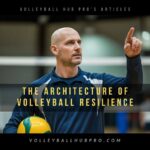
Understanding Volleyball-Specific Strength Needs
Strength in volleyball is not a generic concept; it is a dynamic, multifaceted attribute tailored to meet the sport’s unique demands. Unlike disciplines where sheer force dominates, volleyball requires a blend of explosive power, precision, and control. As coaches, our understanding of strength must extend beyond the simplistic notion of lifting heavier weights or jumping higher. Instead, it must delve into the biomechanics and physiological requirements that define a player’s ability to perform at peak levels.
At its core, strength in volleyball manifests as the foundation of power. Power, in the context of our sport, is the product of speed and force. This interplay is evident every time an athlete explodes off the ground to spike or block, delivering precise, high-velocity movements that depend on a strong, coordinated musculoskeletal system. A spike isn’t just about hitting the ball hard; it’s about generating speed from the legs, transferring energy through the core, and delivering it via a controlled, forceful swing. Each phase relies on specific aspects of strength that we, as coaches, must systematically develop.
Equally critical is the role of strength in agility. Volleyball demands frequent changes in direction—whether it’s lunging for a low dig, pivoting to adjust to a quick set, or reacting defensively to an opponent’s attack. These movements require not just speed but the ability to decelerate and reaccelerate efficiently. A player’s ability to perform these actions without losing balance or risking injury is a direct reflection of their foundational strength, particularly in stabilizing muscle groups.
Stability itself is a key consideration in volleyball-specific strength training. Athletes operate in a state of perpetual dynamic balance, often extending their bodies to reach difficult plays or landing from explosive jumps. Without adequate stability, even well-conditioned players are susceptible to common volleyball injuries, such as ankle sprains or knee ligament tears. Strength training, therefore, must incorporate exercises that fortify stabilizing muscles, such as the core and those around the joints, to ensure athletes can handle the unpredictable nature of gameplay.
Moreover, strength is vital for endurance in volleyball, a sport characterized by short bursts of high-intensity activity interspersed with brief rest periods. A match can stretch over several sets, demanding sustained physical output from players. Strength not only powers these explosive movements but also supports efficient recovery between them. A well-trained athlete is less likely to fatigue, maintaining precision and intensity throughout the match. This endurance is underpinned by a foundation of muscular strength that minimizes the risk of overuse injuries and ensures consistency in performance.
From a developmental perspective, strength serves as a preventative measure against the physical stresses of the game. Volleyball players, particularly at the youth level, often exhibit imbalances stemming from repetitive movements, such as constant jumping or dominant-arm hitting. Over time, these imbalances can lead to poor posture, joint misalignments, and a greater likelihood of injury. Targeted strength training addresses these issues by promoting symmetrical development, ensuring that the body is not only powerful but also resilient and adaptable.
It is important to recognize that strength in volleyball is not a one-size-fits-all concept. Each athlete brings unique physical attributes and challenges to the court, and it is our job as coaches to tailor strength training to individual needs. For some, this may mean focusing on improving vertical jump height through explosive leg exercises. For others, it might involve enhancing upper body strength to improve serving velocity or fortifying core stability to maintain balance during quick directional changes. Understanding these nuances and implementing personalized plans is what sets exceptional coaching apart.
Developmental Stages and Training Focus
The journey of an athlete in volleyball is a carefully orchestrated progression, shaped by the physical, psychological, and technical needs specific to each stage of development. Understanding these stages and aligning strength training with an athlete’s age, maturity, and experience is fundamental to unlocking their full potential while safeguarding their long-term health and performance. As coaches, it is our responsibility to ensure that every step of the process is purposeful, structured, and adaptive.
The earliest stage, encompassing ages 6 to 8, is the realm of unstructured play. At this age, formal strength training is neither appropriate nor necessary. The young athlete’s body is in a state of rapid growth and adaptation, and the natural movements involved in playing games provide all the physical stimulation needed. Running, jumping, climbing, and other playful activities help build a foundation of gross motor skills, coordination, and general physical readiness. The key here is to encourage varied and imaginative play, fostering a love for movement and sport without imposing rigid structures.
From ages 9 to 11, the focus begins to shift toward the development of fundamental movement skills. This period is often referred to as the “sensitive phase” for coordination, where young athletes are most receptive to learning and refining movement patterns. Strength training at this stage remains light and predominantly bodyweight-based, with an emphasis on balance, agility, and mobility. Exercises that involve basic motor skills—such as squats, lunges, and push-ups—are introduced in playful and exploratory formats. The goal is not to build strength in the traditional sense but to prepare the neuromuscular system for more advanced training in the years to come.
As athletes transition into the 12-to-14-year age group, their training takes on greater structure and intent. This stage marks the beginning of formal strength training, with an emphasis on general physical preparation. The introduction of foundational strength exercises, such as bodyweight squats, resistance band work, and light medicine ball drills, allows athletes to start building muscular strength and endurance. This phase also places a high priority on mobility and flexibility, ensuring that developing joints and muscles retain their full range of motion. Coaches must remain vigilant about proper technique during exercises, as the habits formed at this stage will significantly impact the athlete’s future training and injury risk.
The 15-to-16-year age group represents a pivotal period in the athlete’s strength development. This is the stage where training begins to bridge the gap between general preparation and sport-specific requirements. Athletes are now capable of handling more substantial loads, and their programs should start to include exercises that target maximal strength, such as loaded squats, deadlifts, and controlled plyometric drills. Careful attention must be given to progressive overload—gradually increasing resistance and intensity to stimulate strength gains without compromising technique or safety. Concurrently, this stage introduces the concept of training for explosive power, preparing athletes for the quick, forceful actions demanded by volleyball. Mobility, flexibility, and core stability remain integral, ensuring that athletes can perform with efficiency and reduced risk of injury.
For athletes aged 17 and beyond, strength training becomes deeply intertwined with the pursuit of peak performance. These athletes are no longer merely building their physical base; they are refining it for competition. At this stage, training programs are highly specialized and tailored to the demands of volleyball. For example, exercises may focus on enhancing jump height, improving reaction time, or increasing the power behind spikes and serves. Resistance training incorporates heavier loads and advanced techniques, such as Olympic lifts, while plyometric exercises are executed with greater intensity to maximize explosive power. Periodization—a strategic division of training into phases—becomes essential to balance load and recovery, ensuring that athletes peak at the right moments during their competitive season.
Throughout these stages, the guiding principle is progression. Strength training must evolve in tandem with the athlete’s growth, maturity, and skill level. Coaches must resist the temptation to rush development, recognizing that the long-term success of an athlete depends on a solid foundation built gradually and methodically. Pushing a young athlete to train beyond their developmental capacity not only increases the risk of injury but can also undermine their confidence and long-term passion for the sport.
Correcting Imbalances and Preventing Injuries
In volleyball, precision, agility, and explosive power are essential attributes, but their consistent execution depends on a structurally sound and balanced body. Imbalances in muscle strength, joint alignment, or flexibility often lurk unnoticed, creating vulnerabilities that can lead to injury. As volleyball coaches, our task extends beyond refining skills; we must ensure that our athletes’ physical foundations are robust, resilient, and capable of withstanding the demands of the sport. Injury prevention is not an afterthought—it is a core responsibility that directly influences performance, longevity, and overall well-being.
Imbalances in volleyball are common, particularly because of the repetitive and asymmetrical nature of the game. Players frequently perform dominant-arm attacks, serve repeatedly with the same motion, and land from jumps in high-impact positions. Over time, these patterns can create uneven strength development, poor posture, and limited mobility. For example, an outside hitter might develop significant strength and coordination on their hitting side while neglecting the opposite side, leading to imbalances in the shoulders and back. Left unchecked, these discrepancies can evolve into chronic issues such as impingements, overuse injuries, or even stress fractures.
To address these concerns, the first step is identifying imbalances through regular assessments. Tools like the squat test, overhead reach evaluation, and postural alignment analysis provide valuable insights into an athlete’s biomechanical strengths and weaknesses. A coach might notice that an athlete’s knees cave inward (valgus collapse) during a squat, indicating weak hip stabilizers and poor alignment. Alternatively, a player struggling to fully extend their arms overhead may have tight chest muscles or underdeveloped upper-back strength. These observations are not just diagnostic; they form the blueprint for individualized corrective strategies.
Once imbalances are identified, targeted exercises are the antidote. For instance, to counteract knee valgus, incorporating lateral band walks or single-leg Romanian deadlifts can strengthen the gluteus medius and improve knee alignment. Similarly, scapular stability drills, such as rows with resistance bands, address shoulder imbalances while reducing the risk of rotator cuff injuries. The goal is not merely to build strength but to restore functional symmetry, ensuring that all muscle groups work harmoniously to support athletic movements.
Equally critical is the focus on mobility and flexibility, particularly in areas like the hips, ankles, and shoulders, which are prone to restricted range of motion. An athlete with tight hip flexors may struggle to achieve the deep knee bend necessary for optimal jumping mechanics, while limited ankle dorsiflexion can compromise balance and increase the risk of rolling an ankle. Dynamic stretches, foam rolling, and yoga-inspired flows can help restore elasticity and fluidity to these key areas. Coaches should integrate mobility work into every training session, recognizing that flexibility is not a static achievement but a continuous process.
Core stability is another cornerstone of injury prevention. Volleyball movements, from spiking to diving for a dig, rely on the core’s ability to transfer energy and maintain balance. A weak core can lead to compensatory mechanics, placing undue stress on the lower back or hips. Plank variations, anti-rotation exercises, and controlled Russian twists are excellent tools for building a strong, responsive core that supports dynamic play. These exercises not only prevent injuries but also enhance performance by providing a stable platform for explosive actions.
Beyond correcting specific imbalances, a preventative approach involves educating athletes about their bodies and fostering a culture of proactive care. Teach players to listen to their bodies, recognizing early warning signs like joint discomfort, persistent muscle tightness, or fatigue. Encourage them to embrace recovery as an integral part of their training regimen, including adequate sleep, hydration, and post-training stretches. This mindset empowers athletes to take ownership of their health, reducing the likelihood of avoidable injuries.
Training load management is another key aspect of injury prevention. While volleyball requires repetitive high-impact actions, excessive volume or intensity without adequate recovery can quickly lead to overuse injuries. Coaches must carefully design training schedules that balance workload and rest, incorporating lighter sessions or active recovery days as needed. Periodization—structuring training into cycles of varying intensity—helps distribute stress more evenly across the season, preventing burnout and keeping athletes fresh for peak performances.
Finally, injury prevention must be seen as a team effort, involving not only the coach but also medical professionals, strength and conditioning specialists, and the athletes themselves. Regular check-ins with physiotherapists or athletic trainers can identify potential issues before they escalate, while collaboration with strength coaches ensures that corrective exercises are integrated seamlessly into broader training plans. This holistic approach creates a safety net around the athlete, allowing them to focus fully on their development and performance.
Crafting the Training Program
Designing an effective strength training program for volleyball requires more than simply compiling exercises—it demands an in-depth understanding of how the body moves during the game, how athletes develop over time, and how to create a system that builds strength progressively and sustainably. A well-crafted training program aligns with the specific demands of volleyball, enhances performance, reduces the risk of injury, and adapts to the unique needs of each athlete. As coaches, our responsibility is to create a blueprint that transforms physical potential into on-court excellence.
The foundation of any training program lies in its structure. At its core, a volleyball strength program should progress through four primary phases: stability, strength, power, and integration. Each phase builds upon the previous one, ensuring that athletes develop a balanced, functional physique capable of meeting the sport’s demands. Rushing through or neglecting any phase risks creating imbalances or inefficiencies that could undermine both performance and longevity.
The first phase—stability—is about building a strong, reliable foundation. Volleyball athletes operate in a state of constant movement, often executing high-impact actions like jumping, lunging, and diving. Stability ensures they can perform these movements while maintaining control and balance. Core stability is particularly crucial, as the core acts as the body’s central axis, transferring energy from the lower body to the upper body and vice versa. Exercises like planks, side planks, and dead bugs develop this essential component, while single-leg balance drills strengthen joint stability in the ankles, knees, and hips. This phase also emphasizes isometric exercises, where athletes hold positions under tension, teaching the muscles to activate and stabilize effectively.
Once stability is established, the focus shifts to strength development. Volleyball demands explosive actions, such as spiking and blocking, which rely on the ability to generate force rapidly. However, before an athlete can express power, they must first build raw strength. This is achieved through compound, multi-joint exercises like squats, deadlifts, and pull-ups, which target large muscle groups and enhance overall force production. During this phase, coaches should emphasize proper technique above all else, using moderate loads and gradually increasing intensity. Resistance training tools such as dumbbells, kettlebells, and resistance bands allow for varied and targeted progressions. The goal is to ensure that athletes develop proportional strength across all muscle groups, avoiding overreliance on specific muscles that could lead to imbalances.
The third phase is where strength evolves into power. Volleyball is a sport of explosive movements, from leaping for a spike to reacting instantly to a tipped ball. Power training bridges the gap between strength and speed, teaching athletes to generate force quickly and efficiently. Plyometric exercises, such as box jumps, broad jumps, and medicine ball throws, become central to this phase. These drills mimic the rapid, high-intensity movements of the game, training the neuromuscular system to respond with speed and precision. Coaches should gradually increase the complexity of these exercises, starting with low-impact variations before progressing to more advanced drills like depth jumps or lateral bounding. It is critical to monitor fatigue during this phase, as power training places significant stress on the body and requires ample recovery.
The final phase—integration—is where everything comes together. The focus here is on applying the strength and power developed in earlier phases to volleyball-specific movements. This phase involves exercises that closely simulate in-game actions, such as approach jumps with resistance, rotational core exercises that mimic spiking mechanics, and agility drills that replicate defensive movements. Coaches should also incorporate proprioceptive training, using tools like balance boards or unstable surfaces to simulate the unpredictable conditions athletes face during matches. The aim is to ensure that athletes can seamlessly transfer their physical improvements to the court, executing skills with enhanced speed, power, and control.
An effective program also requires careful consideration of frequency, duration, and recovery. Ideally, strength training sessions should be performed two to three times per week, depending on the athlete’s age, experience, and competition schedule. Each session should last between 60 and 90 minutes, with a clear balance between working and resting. Overtraining can lead to fatigue, reduced performance, and a higher risk of injury, so coaches must plan for adequate recovery both within and between sessions. Periodization, or the strategic division of training into cycles, helps manage workload and ensures athletes peak at the right time during their season.
Progression is another cornerstone of a well-designed program. Coaches must continually challenge athletes by increasing resistance, complexity, or intensity, but this must be done methodically to avoid overwhelming the athlete’s physical capabilities. For example, once an athlete masters bodyweight squats with perfect form, they can progress to weighted squats. Similarly, plyometric drills can transition from low to high boxes as the athlete’s power and coordination improve. This gradual approach not only ensures steady development but also builds confidence and competence.
Finally, the program must be individualized. No two athletes are the same, and their training should reflect their unique strengths, weaknesses, and goals. A middle blocker might focus on vertical jump enhancement, while a libero may benefit from agility and lateral movement drills. Similarly, younger athletes require less intensity and more emphasis on movement quality, while experienced players can handle more advanced training. Regular assessments and open communication with athletes allow coaches to tailor the program to their evolving needs, maximizing its effectiveness.
The Unique Needs of Female Athletes
Strength training for female volleyball players is both an opportunity and a responsibility. Female athletes possess unique physiological characteristics that influence how their bodies respond to physical demands and training stimuli. Recognizing these differences is not about lowering expectations but about tailoring programs to ensure they achieve peak performance safely and effectively. As volleyball coaches, our mission is to understand these nuances, design training regimens that address them, and empower female athletes to excel in a sport where agility, power, and precision are key.
One of the most significant differences between male and female athletes lies in joint laxity and flexibility. Female athletes naturally exhibit greater joint mobility, a characteristic that can be both a strength and a vulnerability. While this flexibility allows for impressive range of motion, it also means their joints are less stable and more susceptible to injuries such as ligament sprains and tears. This is especially true for the knees, which are at increased risk due to the structural differences in the female pelvis. A wider pelvis creates a greater Q-angle (the angle at which the femur meets the tibia), placing additional stress on the knees during dynamic movements like jumping, landing, or cutting. As a result, ACL (anterior cruciate ligament) injuries are significantly more common in female athletes than in their male counterparts.
To mitigate these risks, strength training programs must prioritize joint stabilization and muscle balance. Exercises that target the muscles around the knee—particularly the quadriceps, hamstrings, and gluteus medius—are essential for enhancing joint integrity. For example, lateral band walks strengthen the glutes and help correct knee alignment, while Nordic hamstring curls improve hamstring strength and reduce strain on the ACL. Coaches should also focus on teaching proper landing mechanics, ensuring that players absorb impact through their hips and knees rather than letting their knees collapse inward (valgus collapse). This proactive approach not only prevents injuries but also enhances performance by providing a stable base for powerful movements.
Another key consideration is the inherent differences in muscle mass and strength between male and female athletes. Women typically have less muscle mass than men due to lower levels of testosterone, a hormone that plays a central role in muscle growth. On average, women possess about 63% of the upper body strength and 75% of the lower body strength of men. While this may seem like a limitation, it simply means that female athletes benefit immensely from well-designed strength training programs that focus on building muscle efficiently. Resistance training using bodyweight, resistance bands, and free weights is particularly effective for increasing both strength and muscle endurance in female players. These gains not only improve their ability to generate explosive power but also contribute to overall resilience and longevity in the sport.
Flexibility, while advantageous in some contexts, can also present challenges when combined with the demands of strength and power. Female athletes often have a higher range of motion than their male peers, which allows them to reach extreme positions during play. However, this flexibility can lead to instability if not paired with sufficient strength. Overstretching or hyperextending joints—such as during a spike approach or a defensive lunge—can place excessive strain on tendons and ligaments. Coaches should ensure that flexibility training is balanced with exercises that enhance muscle control and joint stabilization. For instance, controlled dynamic stretches and eccentric loading exercises can improve both flexibility and the ability to manage extreme ranges of motion safely.
The hormonal fluctuations inherent to the female menstrual cycle also influence training outcomes. Changes in estrogen and progesterone levels can affect energy levels, recovery, and even ligament stability. For example, studies suggest that estrogen surges during the ovulatory phase may increase the risk of ACL injuries due to temporary ligament laxity. While these hormonal shifts are natural and should not deter training, they emphasize the importance of monitoring fatigue and adjusting workloads as needed. Open communication with athletes about how they feel during training and competitions allows coaches to make informed decisions and provide the necessary support.
In addition to physical considerations, it is important to address the mental and emotional aspects of training female athletes. Many young women face societal pressures regarding body image, which can influence their perceptions of strength training. Some may fear that building muscle will make them appear “too bulky,” while others may be hesitant to push their physical limits. As coaches, it is our job to educate athletes about the benefits of strength training, emphasizing how it enhances performance, reduces injury risk, and builds confidence. By creating a positive and supportive environment, we can help athletes embrace their physical strength as a source of empowerment.
Finally, the differences between male and female athletes are not limitations; they are simply variables that guide how we approach training. Female volleyball players are incredibly capable of achieving high levels of strength, power, and athleticism when given the right tools and guidance. Coaches who understand and address their unique needs are not only preparing them for success on the court but are also contributing to their overall health and well-being.
From Training to Transformation
Volleyball is much more than a game of power and precision—it is a stage where athleticism, teamwork, and resilience converge. Strength training in volleyball is not simply a mechanical process of building muscle or improving performance metrics. It is a transformative journey that shapes players physically, mentally, and emotionally. For coaches, the final step in crafting an exceptional training regimen is guiding athletes to integrate their physical capabilities into a cohesive, confident, and peak-performing whole. This chapter explores how strength training transcends its technical components, driving players to excel on the court and beyond.
The transformation begins with the practical application of training outcomes. Over weeks and months of deliberate strength programming, athletes gain the physical tools necessary to perform at higher levels. The explosive power developed through plyometrics translates into higher jumps for spikes and blocks. Core stability work enhances balance, enabling players to execute defensive movements with precision and recover quickly after dives. Mobility drills improve the efficiency of swings, reducing strain and increasing the consistency of powerful serves. The beauty of this transformation lies in its subtlety; athletes often discover their newfound abilities instinctively during play, seamlessly integrating improved strength and agility into their game without conscious effort.
However, the physical gains are only part of the story. Strength training fosters a deeper understanding of body awareness and control. Athletes learn to move intentionally, understanding how to generate power from the ground up, transfer it through their core, and deliver it through their arms and legs. This heightened proprioception not only refines technique but also builds a level of confidence that can only come from knowing one’s body is fully prepared to meet the demands of the sport. It is this internal transformation—this sense of readiness and mastery—that separates great players from good ones.
Mental resilience is another key benefit of the strength training journey. Volleyball is as much a mental game as it is a physical one, requiring athletes to stay composed under pressure, recover quickly from mistakes, and adapt to ever-changing situations. The discipline and effort required in strength training naturally cultivate these qualities. Athletes who push through challenging workouts, overcome physical limitations, and achieve incremental progress learn to embrace discomfort and view setbacks as opportunities for growth. They develop the mental toughness to face tough matches with determination and focus, knowing they have the preparation to rise to any challenge.
Moreover, strength training fosters a culture of accountability and teamwork. In volleyball, success depends on the collective effort of the team, and training together strengthens this bond. Group workouts provide opportunities for players to encourage one another, share in accomplishments, and hold each other accountable. Whether it’s completing a tough set of squats or mastering a new plyometric drill, the shared experience of overcoming physical challenges strengthens trust and camaraderie. This sense of unity often carries over into matches, where players who have trained together with discipline and purpose are more likely to communicate effectively and work cohesively under pressure.
In addition to physical and mental development, strength training has a profound impact on an athlete’s sense of identity and self-worth. For many young players, training becomes a space where they discover their potential, build confidence, and develop a healthy relationship with their bodies. Strength training empowers athletes to view their physical capabilities as assets rather than limitations, breaking down societal stereotypes and reshaping narratives around strength and femininity. For female athletes in particular, this journey can be transformative, fostering a sense of pride in their physical strength and resilience.
The role of the coach in this transformative process cannot be overstated. Coaches are not merely instructors—they are mentors, motivators, and architects of growth. By creating a structured yet adaptable training program, providing consistent feedback, and celebrating progress, coaches inspire athletes to commit fully to their development. Equally important is the ability to foster reflection, encouraging athletes to recognize and internalize their progress. Asking questions like, “How did you feel after executing that drill?” or “What do you notice about your performance compared to last season?” helps athletes connect their training efforts to tangible results, deepening their sense of accomplishment and motivation.
The success of a training program is measured not just by improved performance metrics but by the broader transformation it inspires. Stronger athletes are not only better prepared to meet the physical demands of volleyball but are also more resilient, confident, and self-aware. They carry these qualities into every aspect of their lives, approaching challenges with discipline, adaptability, and determination.
The Guides of Volleyball Hub Pro
If you’re looking to delve deeper into this topic, we highly recommend reading the following books authored by our team:










